FC Nordsjælland have had a mixed start to their Danish Superliga campaign so far. They burst out of the blocks, but recent losses in the league have seen them slip down to fifth in the league; meanwhile, in the UEFA Europa Conference League, they have been free-scoring with 10 goals in three games. An exciting transfer market saw them lose Ernest Nuamah for a €25 million fee, where he is currently at Ligue 1 side Olympique Lyon, which allowed academy star Andreas Schjelderup to return from Benfica on loan just before the deadline. This is nothing new for a side that has produced talents like Mohammed Kudus and Simon Adingra through their Right to Dream Academy, where a new talented prospect is always on the horizon.
From set plays, Nordsjælland are approaching double figures in goals scored or earned from set pieces. During the opening couple of weeks, the Danish side had a period where they would average a goal every 5-6 corner kicks, although that rate is impossible to sustain.
In this tactical analysis, we will look into the tactics behind FC Nordsjælland’s attacking corner setups, with an in-depth analysis of why their impeccable timing of runs has been highly effective so far. This set-piece analysis will examine how the different variations have been effective, the reasons for varying their corners, and the potential room for improvement to become the most threatening set-piece side they can be.
The Importance of Timing
Just like in open play, the value of arriving in space rather than waiting in space is crucial. Defending sides can’t see all the space and gaps available in the box but can more simply track each attacker. If an attacker finds a space and gets there too early, he is likely to be tracked by a defender while he waits for the ball to arrive, where there is a 50/50 duel between the pair. However, suppose an attacker can time their movement and arrive in the space at the same time as a ball does. In that case, a defender, even if they are just one step behind, won’t be able to get to the ball in time before the attacker, who can have an unopposed attempt at attacking the ball.
From corners, Nordsjælland have mainly stuck to the attacking structure below, although there have been slight variations to the positions of players around the box or coming to receive a short pass. A close unit of four attackers on the six-yard line, with one attacker nearer the goal and one by the near side of the six-yard box, making up the players’ positions inside the box. The neutral, consistent starting positions of the players for every corner makes Nordsjælland a team that is hard to set up against, with the side making their movements in the last second, just before the corner is taken. This means that the defenders have no time to react to alternate runs or unanticipated actions, giving each attacker the advantage.
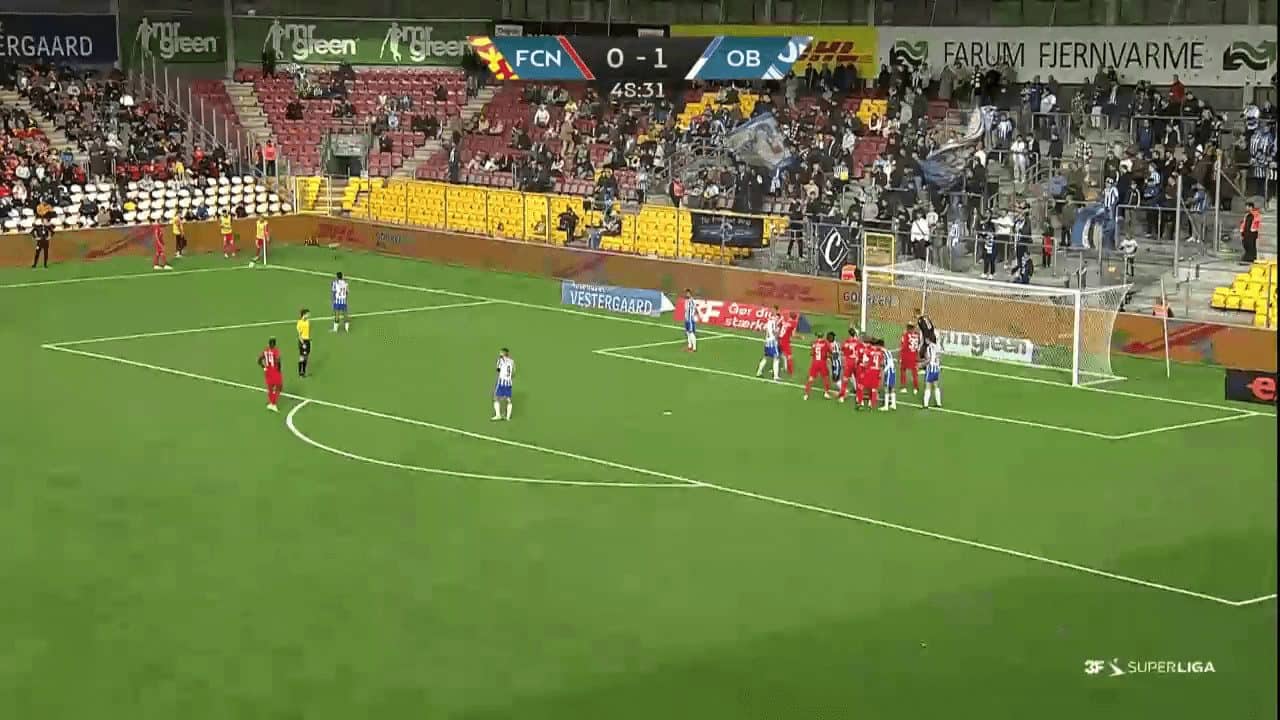
One of the benefits of having a pack of four players starting in touching distance with each other is that it makes it easier for each individual inside the pack to lose their marker. When one player makes a run around the pack, his marker has the option to either follow behind him, instantly giving him the separation needed, or to run around the opposite side of the pack, aiming to arrive in the space at the same time as the attacker. However, the attacker has the advantage of knowing where the space he has to arrive in is whilst his marker is playing a guessing game.
In the example below, we can see two attackers making their move around their teammates whilst their respective markers take the long way around the pack. Following the kick of the corner, the Nordsjælland attacker is able to arrive in the planned space, whilst his marker is unaware of where that space is and has to react to the attacker’s movement. The fact that the defender has to react means he arrives in the space a second behind the attacker, but with Nordsjælland’s moves having the perfect timing, the attacker only needs one second worth of time to execute their headed attempt on goal before the defender arrives and it’s too late.
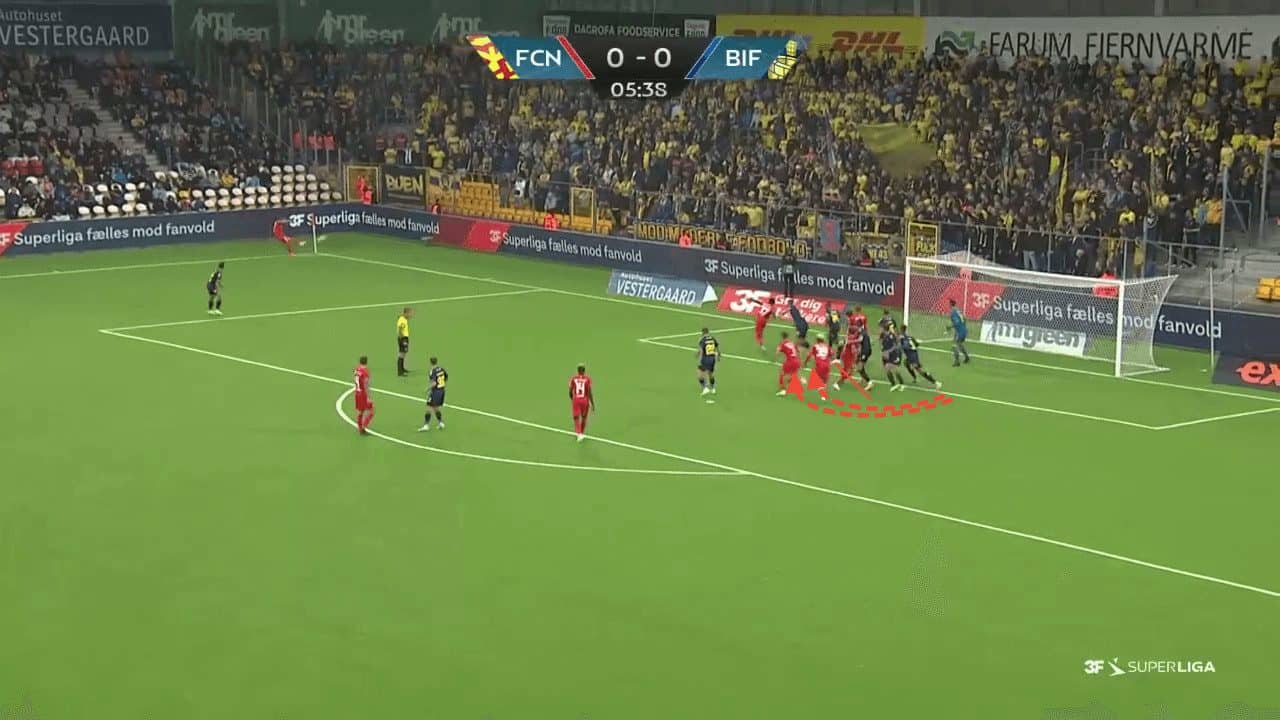
Even whilst using slight variations, the timing of each run is crucial to Nordsjælland’s success from set plays. In the example below, we can see one zonal defender protecting the area they want to attack. Even though that defender’s job is to cover just that one zone, his open body language, facing both the ball and the attackers, tells us that he is equally concerned about the players as his zone.
With the defender clearly concerned about the attackers’ runs, Nordsjælland used the defenders’ indecisiveness to their advantage by doing exactly what he feared. The attacker nearest to the zonal defender, who is most visible to the defender, makes a run across the face of the defender, dragging him out of position.
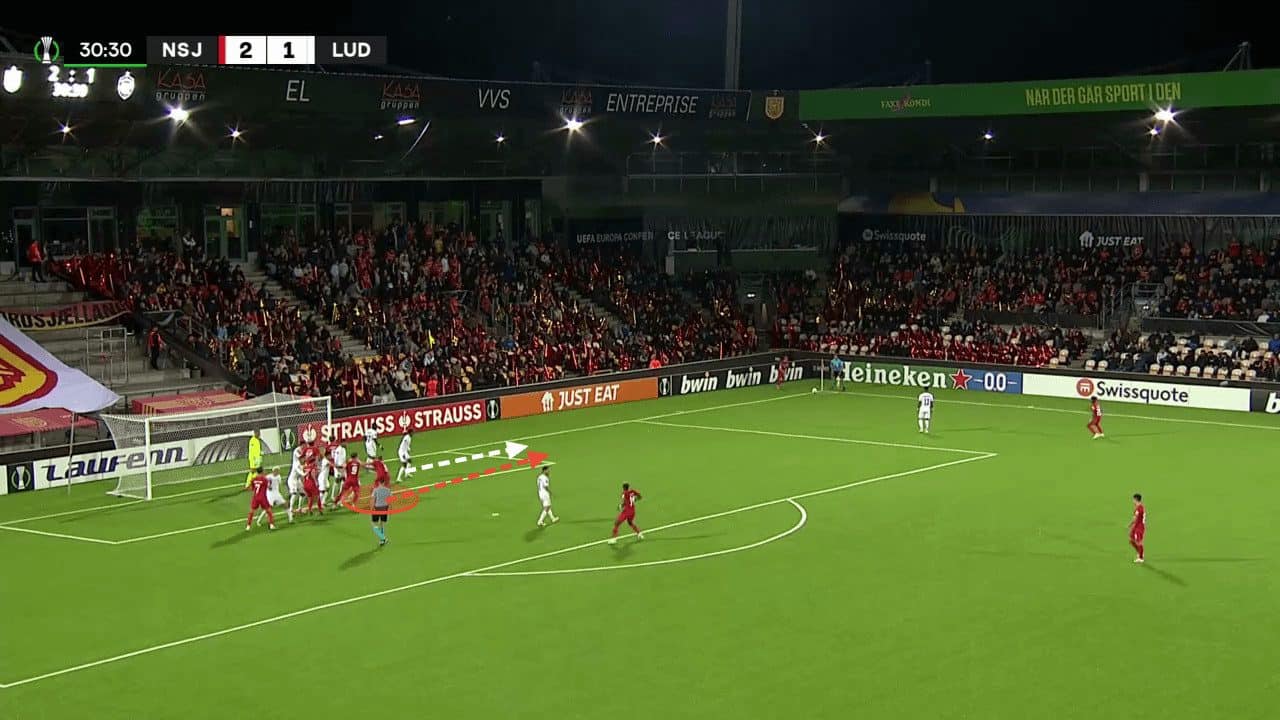
After Nordsjælland have been able to clearly open up space in their desired zone, half the job is complete. All that is required for Nordsjælland, once a zone is identified, is to accurately deliver the ball into that area and have an attacker time their run to arrive in that space simultaneously as the ball will. Whilst this is not an easy skill and something that many teams struggle with, Nordsjælland have consistently been able to take advantage of the smallest gaps just by arriving in the space. In contrast, many teams often have players waiting in the space, attracting defenders in the process.
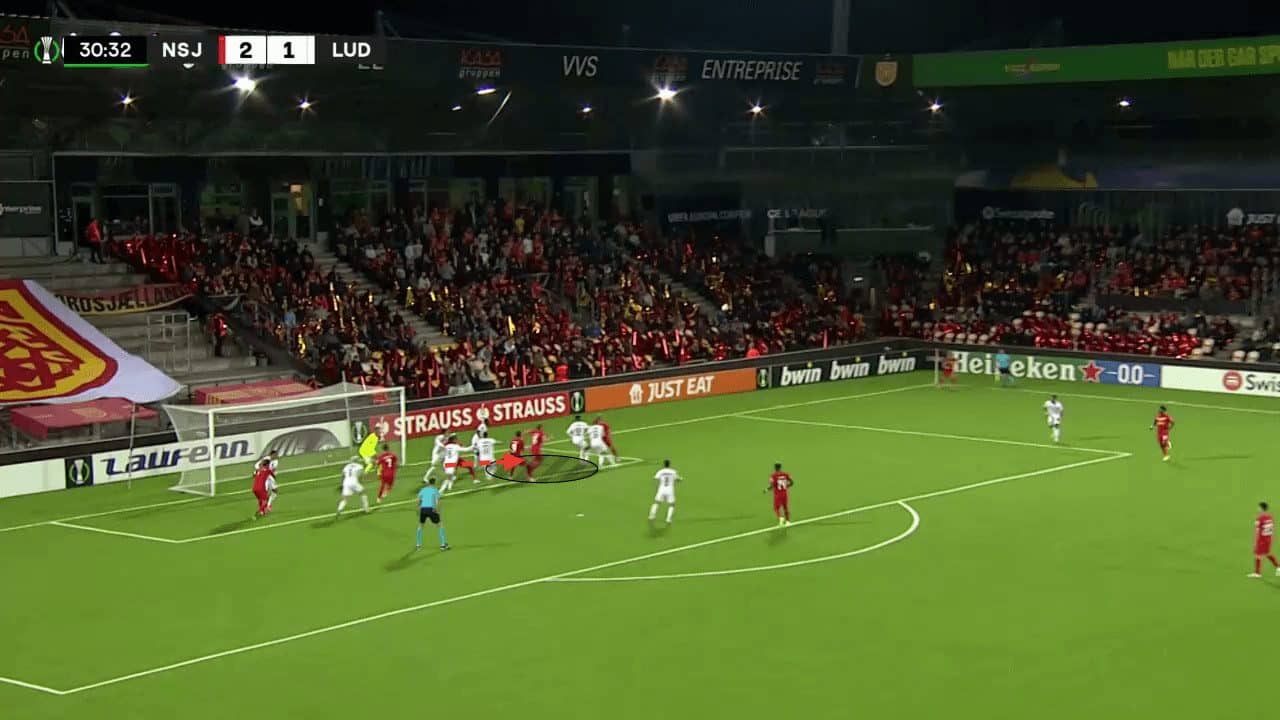
In the example below, we can see a similar defensive structure to the example prior. However, there is one key difference. The zonal defender by the near side of the six-yard box has his back turned to every attacker, only having his eyes on the ball. This tells Nordsjælland that this defender will protect his zone, with that zone having 100% of his focus, which also informs the players that the player will not be able to track any runners, as he has no awareness of the positions of any of them.
In the instances where it is clear a zonal defender will definitely stay in his zone, Nordsjælland have had players making the run across the face of the zonal marker, knowing that they can safely deliver the ball into the near side of the six-yard box to an unmarked player. Of course, a defender will follow the run made in the example below; however, as discussed earlier, the attackers only need a yard of space from their markers to arrive in the space and make contact with the ball before a defender can get there.
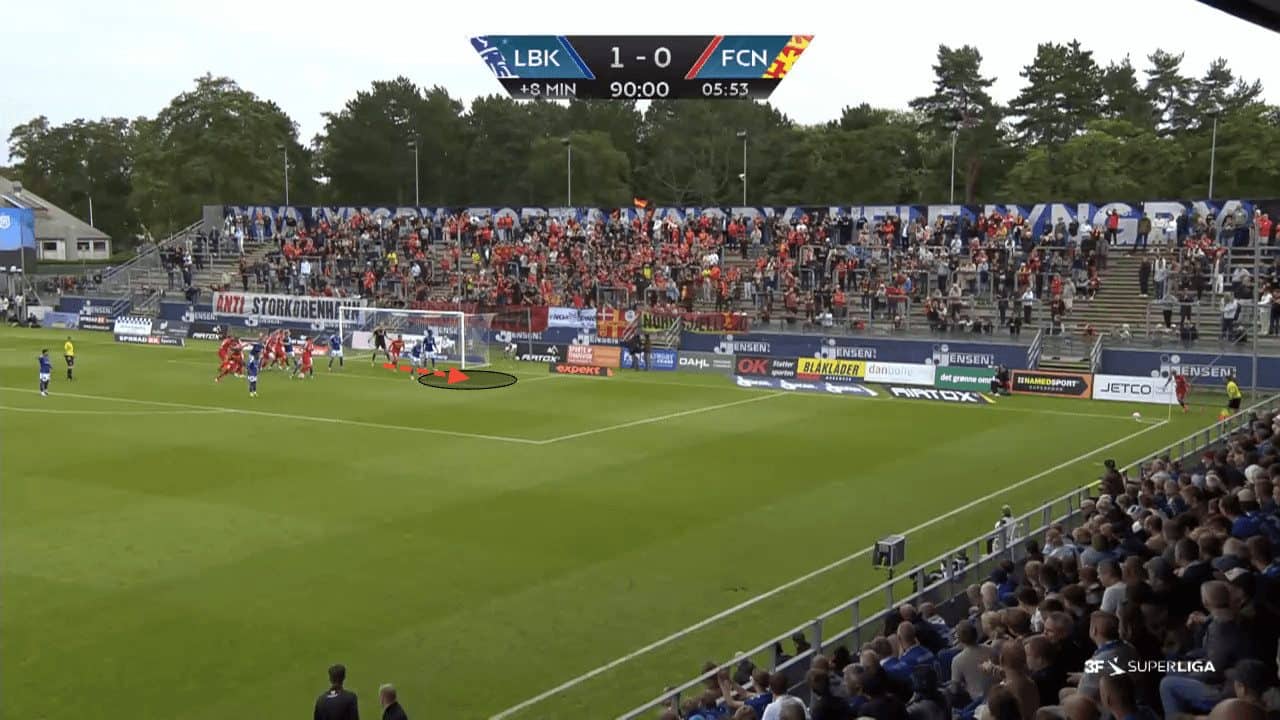
From these situations where the attacker making contact with the ball has run ahead of the zonal defender and is ahead of the front post, it can be difficult to get the headed effort on target, although not impossible. In these situations, it can be common for the header to simply be redirected across the face of the goal, where one of the players in the pack attempts to break off towards the back post, where they have a simple tap in into an open goal.
Although the tap-in at the back post should seem like the easiest task, the structure of the attacking unit makes this a difficult task for players inside the pack. The positions of the Nordsjælland players, where four or five players are in a line parallel to the goal, means that a defender is able to be directly in the path of the attacker’s attempt to get to the back post. The pack gives players the potential to gain separation when either making a movement towards the near post from the back of the pack or the back post from the front of the pack. However, short and sharp movements direct to goal are hard to make with the defenders being in touching distance from the beginning, so attackers must outmuscle their markers to break through and attack the goal straight on.
In those instances, Nordsjælland must find a workaround to be able to make the most of the flicks across the face of the goal. This could be achieved through runs from deep, where an attacker has the separation from their marker and can attack the goal with speed, and a defender’s attempt to block the run would be deemed as obstruction. Another possibility is for attacking pairs to cooperate, where one attacker performs a screen on his teammate’s marker to give him the clear path needed to attack the goal. There are many different ways in which Nordsjælland can attempt to focus on maximising the chance of making the second contact from these situations rather than only the first contact, even though that is the most essential part of the corner.
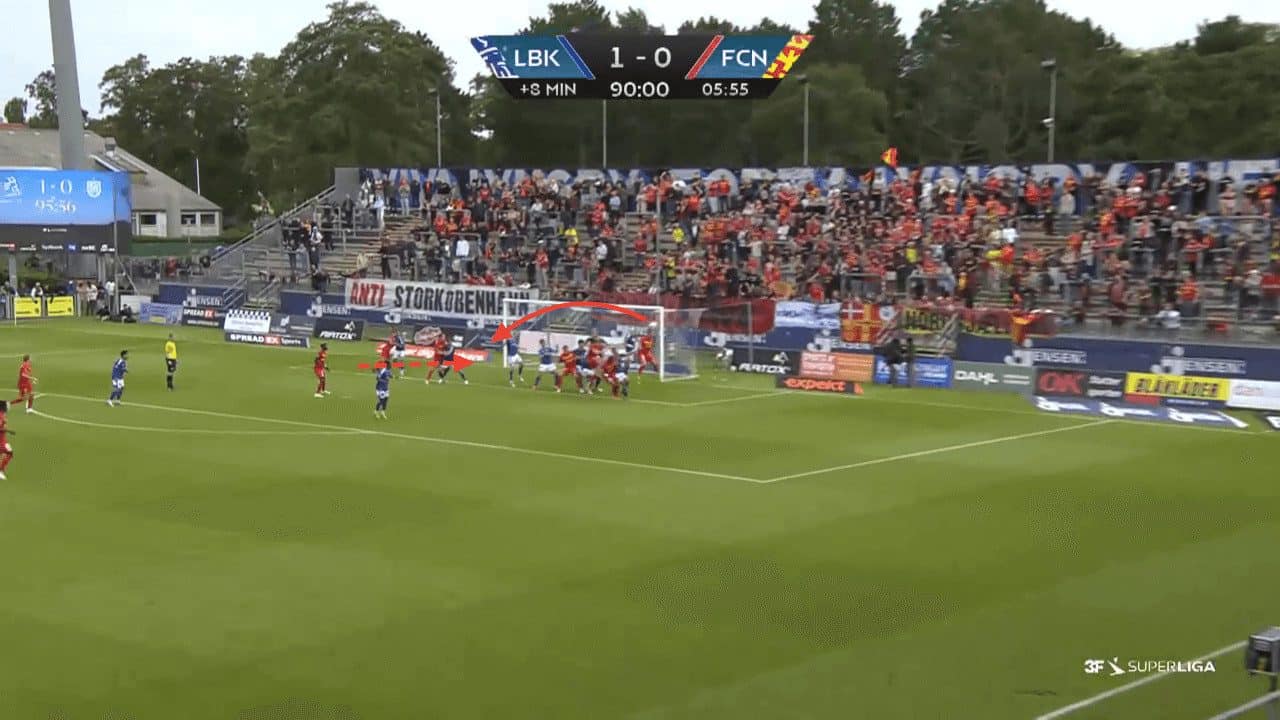
Nordsjælland have been able to adapt to where the space is rather than forcing through one type of corner constantly. We can see in the example below two zonal defenders closing off the potential easy route of attacking the near side of the six-yard box. Instead, there is space by the back post or deeper from the goal.
One way in which Nordsjælland have exploited this has been through gaining backward separation, where the attempt is made from a further distance but with the benefit of an unopposed headed effort on goal. In the example below, around the penalty spot, Nordsjælland have a 3v2 numerical advantage.
This can simply be taken advantage of through unselfish screens from teammates immobilising the two man markers, ensuring that the third attacker has no one picking him up, and the ball just has to find him. With the heavy zonal defence, the space is further away from the goal, but it is easier to ensure the first contact for the attacker, with so few defenders attempting to mark the deepest attacker.
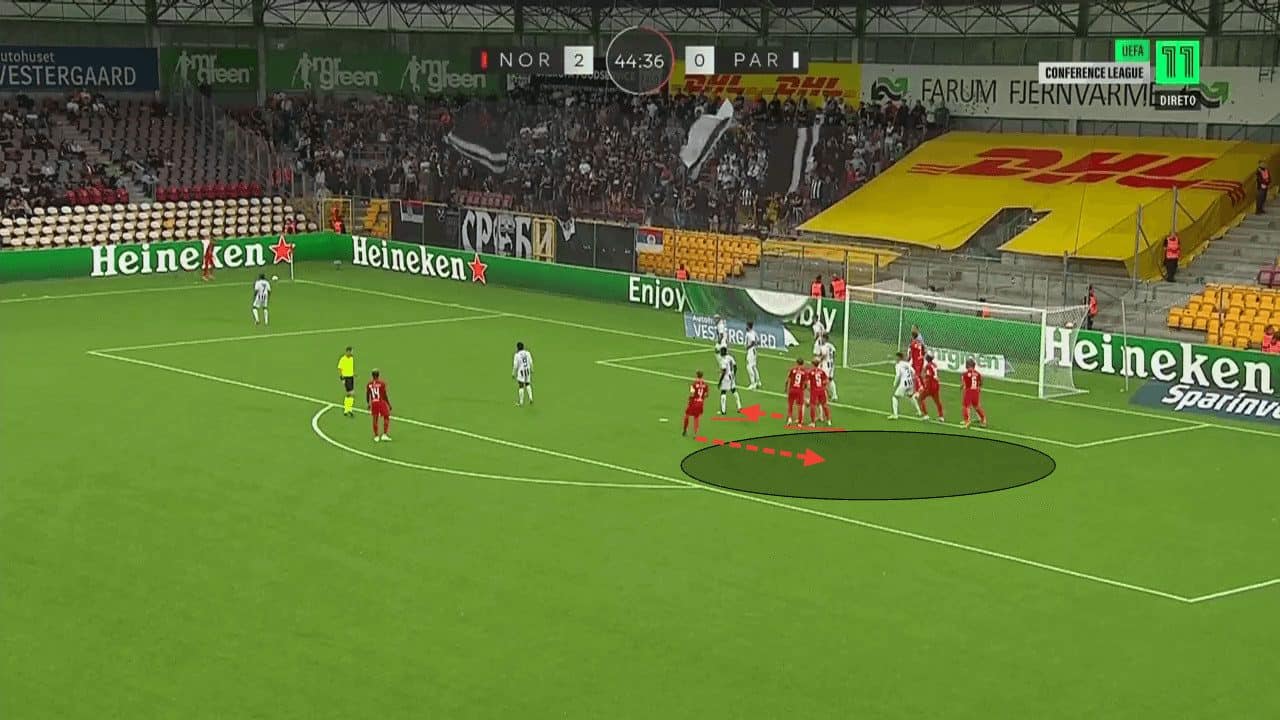
As with every corner Nordsjælland attempt, timing is crucial. We can see the target area for the corner below is at the back of the six-yard box, where no zonal defender is positioned, whilst the near side has two. However, even though the space is at the back post, all the players are already positioned near there, like they are with every corner, in an attempt to seem neutral. This doesn’t seem to align with their principle to arrive in the space.
While the space doesn’t seem too big, the defenders near that area are all busy man-marking their individual attackers, meaning that any ball that goes over their head isn’t their responsibility. These defenders will assume they are safe as no one is behind them. This changes when a run from deep is made, and that attacker arrives at the back post, with the run being timed perfectly for the attacker to attack the ball while sprinting. This ensures he can jump to his peak, giving him the advantage in the aerial duel over his marker, who has a lesser run up, and header the ball with maximal power as well.
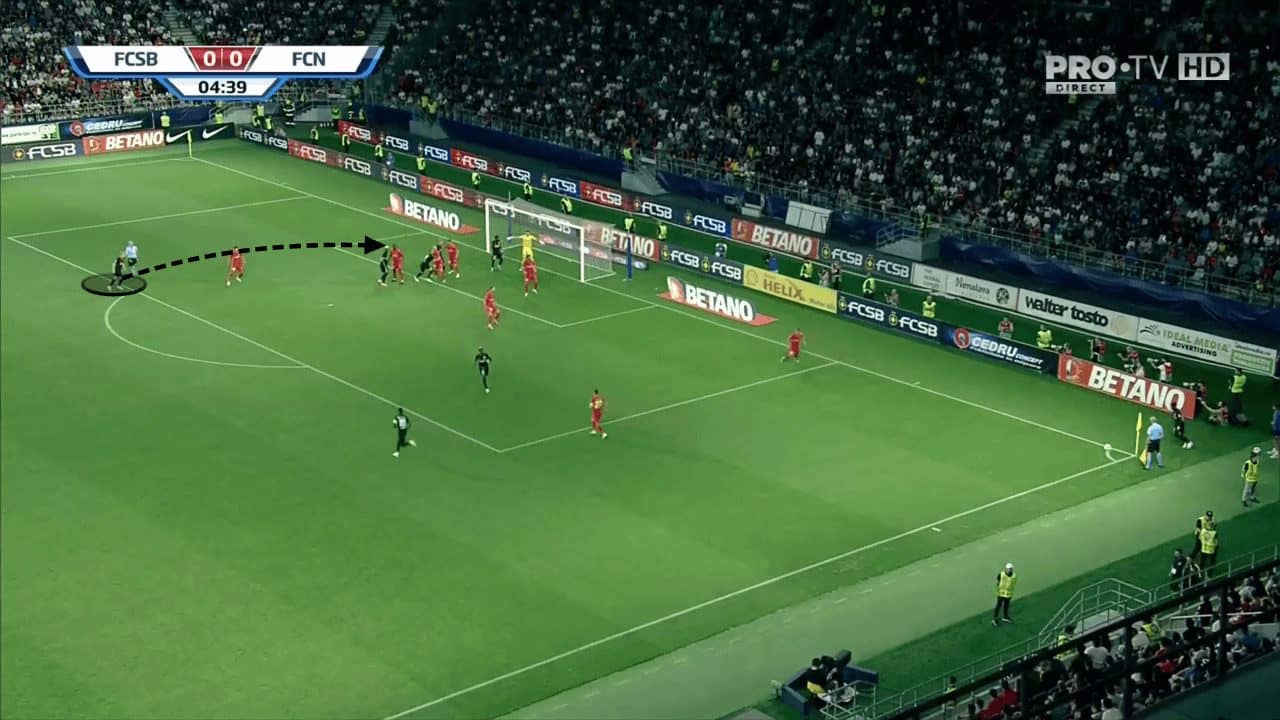
Below, we can see another variation against a team that has most of their defenders inside the six-yard box, leaving space around the penalty spot. When a team’s defending unit is exclusively in their six-yard box, it provides the attacking team with the potential to trap them inside that area and suffocate them by not allowing them to leave that area.
This is made possible by having each attacker around the six-yard box performing a screen as seen below, where one attacker can make their run from deep into the open area, whilst no defender can come out to intercept the ball as they are trapped behind the red wall of Nordsjælland players. This routine could be optimised by having the furthest player from the target area provide a screen to instead form that screen in front of the target attacker’s marker.
The zonal defender by the back side of the six-yard box will have no interest in stopping a low cross to the near side of the six-yard box, so he isn’t a threat to the corner being intercepted. Therefore, that screen could be used on more important matters, like the target player’s marker, who hasn’t been shaken off.
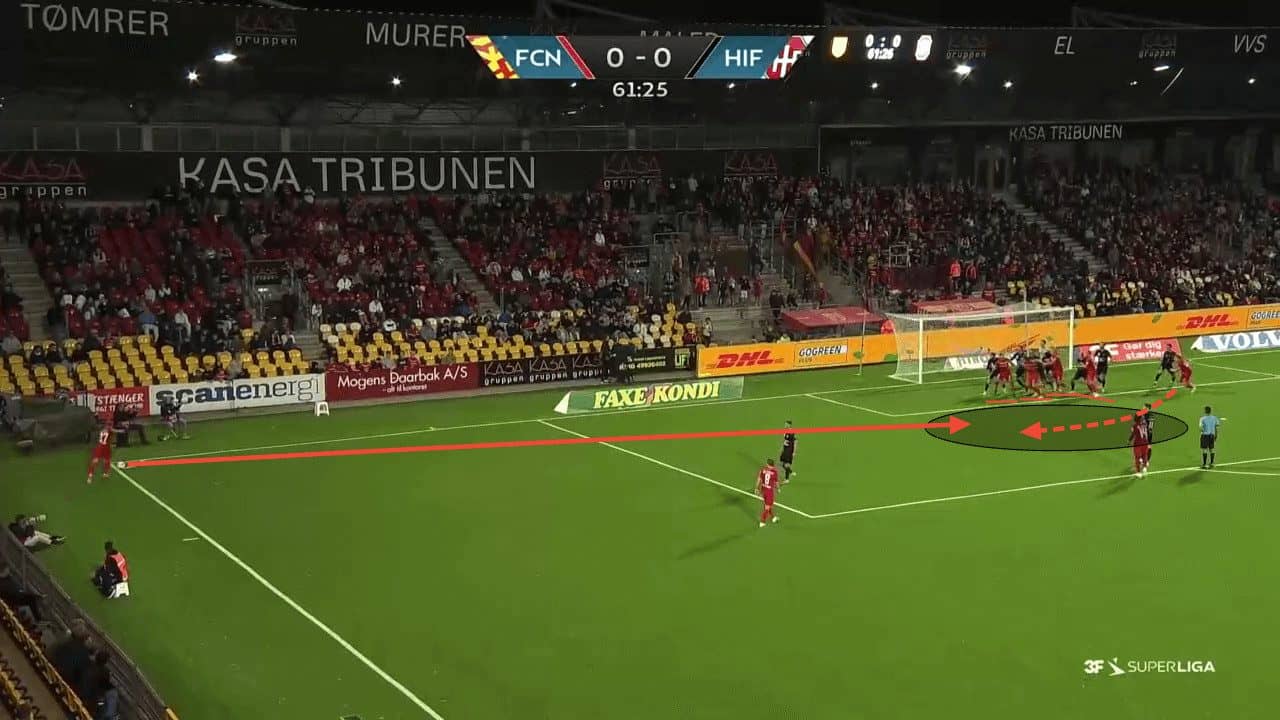
Summary
This set-piece analysis has detailed the numerous different ways in which Nordsjælland have adapted to their opponent’s defensive structures and how Nordsjælland have been able to consistently get the better of their opponents. Through impeccable timing of their runs, the Nordsjælland attackers have been able to make the first contact on many crosses, even when the conditions weren’t favourable.
In the future, Nordsjælland could optimise their corners by being slightly braver in their structure. Attacking corners with only five or six players also makes defending against them more favourable, as those perfectly timed runs won’t be possible to perform against a side that packs their box with both zonal defenders and man markers. This is especially relevant to the structure that Nordsjælland use, with every player starting at the six-yard box.
In their structure, there is no space to exploit between the defenders and the goal, but only at the front post or back. Moving the starting positions of the attacking unit deeper would give the attackers the added potential of exploiting space in behind the defenders, giving the defending side another problem to worry about.






Comments